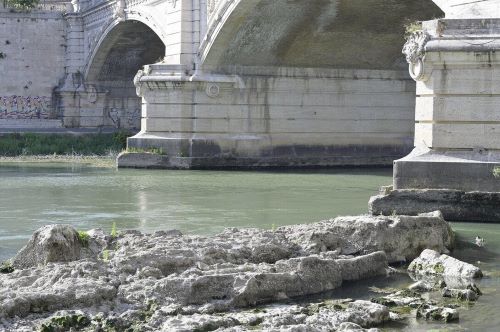Due to the drought, we are currently experiencing in Rome, the level of the Tiber has dropped by about 1.5 metres and ancient ruins have reappeared from the dry bed of the Tiber. But what are they? It is not easy to figure them out…they are the ruins of the famous Neronian Bridge. The ruins of this bridge which hare appeared from the dry bed of the Tiber, have resurfaced near Castel Sant’Angelo. Should you wish to see them, we would be glad to point them out to you during one of our Vatican and Castel Sant’Angelo Tours.
THE DRY BED OF THE TIBER
The Tiber is thirsty. The severe drought that is affecting a large part of Italy has also made the river that flows through Rome, almost unrecognisable. The watercourse level is now about one and a half metres lower than average: a dramatic situation! And as a result of this situation, the ancient remains of the Neronian Bridge, also known as Ponte Trionfale, have emerged from the dry bed of the Tiber.
Ruins that had been buried for so long by the waters of the river are now clearly visible.

Ruins of the Neronian bridge appear from the dry bed of the Tiber
THE NERONIAN BRIDGE
But what do we know about the Ponte Neroniano than has appear from the dry bed of the Tiber? To what era do these ruins resurfaced near Castel Sant’Angelo date back? What we know is that the Neronian Bridge allowed to cross the river Tiber and allowed the communication between Rome and Veio through the Via Triumphalis. It seems that the bridge was commissioned by the emperor Nero in the 1st century. His aim by constructing the bridge was to enhance the city circulation and to streamline traffic. Other historians say that its construction is be attributed to Caligola. It seems he wanted to facilitate access to his circus, thus dating the bridge, several years earlier.
In addition to this, according to historians’ reconstructions, the bridge fell into disuse following the building of the Aurelian Wall (270-275 AD). The remains of the pylons were later destroyed in the 19th century to facilitate navigation in the Tiber.
So, the ruins of this bridge (which hare appeared from the dry bed of the Tiber) have resurfaced near Castel Sant’Angelo. Should you wish to see them, we would be glad to point them out to you during one of our Vatican and Castel Sant’Angelo Tours. Come to Rome! Come and #feeltheessence!

